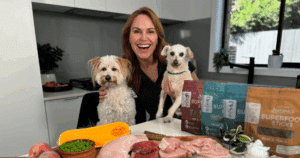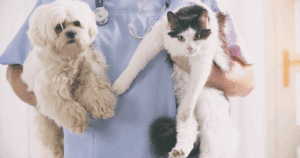
We talk a lot about the benefits of a raw food diet for dogs on this website and on our TV show.
Rather than just take our word for it though, we thought we’d get some insights from Clinical Naturopath and herbalist, Narelle Cooke about the benefits of a raw food diet for dogs, even if you still feed your dog a kibble.
A healthy and balanced diet provides the building blocks for our dogs to achieve optimal wellness. I have seen first hand some of the health benefits of feeding a more natural, species appropriate diet to our dogs including:
In my opinion, feeding a kibble diet alone is never optimal, and how I usually ask my clients to think about it is to imagine how they would feel if they were told to only feed their children highly processed cereal from a box for every meal for their entire lives!
Cereal, like kibble, may have vitamins and minerals added back in, so in that sense, it will keep them alive, but ultimately it’s dead food.
All of those amazing and beneficial enzymes that our dogs need to fully digest and absorb the nutrients from their food are lost. Synthetic vitamins and minerals also work very differently in both our own and our dog’s bodies as compared to those from fresh, whole food sources.
And for both humans and dogs, we now know that eating food as close to its natural form as possible is by far our best bet for improving health and preventing disease.
Unfortunately, pets are now following in our footsteps in terms of the chronic health problems they’re suffering from.
For example, some of the top ailments now afflicting dogs are things like obesity, diabetes, heart disease, and cancer. And much of this can be traced back to the type of diet that the average pet dog is being fed, which is way too high in carbohydrates for what a dog actually needs, and which often contains artificial colours, flavourings and preservatives, which have all been shown to be detrimental to health.
For many dog owners, feeding kibble is necessary for a variety of reasons. So, one of the best ways to improve the quality of whatever diet you feed your dog is to add in some fresh whole foods. This should include things like:
Choosing a complete and balanced raw food diet, produced by a manufacturer you can trust, like Big Dog Pet Foods is a great choice.
Many dog owners simply don’t know where to start when adding fresh foods to their dog’s diet, and often resort to only feeding cooked chicken, rice and vegetables day in and day out.
Unfortunately, that type of diet is highly unbalanced and deficient in a number of essential nutrients that dogs need to be healthy long term.
The most obvious one in this example is calcium. Many pet owners are not comfortable feeding whole raw bones to their dogs, and so simply don’t give them. But this results in a calcium deficiency and an imbalance between calcium and another mineral called phosphorus.
For puppies, this type of diet will result in improper skeletal development. It will also make dogs more prone to conditions such as hip dysplasia and arthritis longer term. (Have a read here on introducing puppies to a raw food diet).
A diet that contains only chicken meat is also way too high in the pro-inflammatory omega-6 fats and too low in the healthy, anti-inflammatory omega-3 fats.
So there’s actually quite a bit to think about when adding fresh food to your dogs diet. To give you and idea, read here for the DIY ingredients that you would have to include each day in your dog’s diet to ensure it was complete and balanced.
Given that I do this for a living it’s a lot easier for me to create complete and balanced meals for my own dogs and for my clients, but there are times when even I’m just too busy or just unmotivated to figure out what to feed them.
This is why I always have a box or two of Big Dog raw patties in my freezer as they are complete and balanced, so owners can have peace of mind that their dog is getting everything it needs from a nutritional stand point.
There is nothing artificial or synthetic added – it’s just real, whole foods and the quality of the produce used is human grade, which is also very important.
Many pet owners may not realise that the ingredients used in many commercial dog foods are of very poor quality and basically the waste material that we, as humans, can’t consume. Plus, I’m impressed by the variety of ingredients included in each pattie and the blended patties also means that dogs are getting the calcium they need from raw bone, without any of the risks of feeding whole raw bone.
The first thing you need to do when mixing raw food with kibble is to make sure that you decrease the amount of commercial kibble food your dog gets, so that you don’t increase the total number of calories you’re feeding and cause unhealthy weight gain.
The next most important thing is to slowly introduce the raw food bit by bit. Read here for why and how to transition your dog safely to minimise the likelihood of stomach upsets and also help fussier dogs adjust to the new food.
While I support the benefits of a raw food diet for dogs alone, there is still enormous benefit from feeding part kibble and part raw – that’s how I started out with my own dogs.
Lara Shannon is a certified dog behaviourist and trainer, pet food nutrition specialist, Executive Producer and Host of Pooches at Play on Channel 10 and editor of Poochesatplay.com. Lara also runs her own dog training business in Melbourne’s Bayside area and is the Author of World of Dogs and Eat, Play, Love (Your Dog).

Dog Treat Naturals Superfood Sticks



Poor gut health and dog behaviour issues



Get your paws on Lara Shannon’s best selling books ‘Eat, Play, Love (your dog) and World of Dogs.
Available in Australia, USA, UK and Canada.